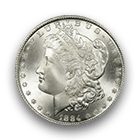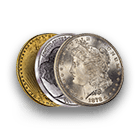Few modern coins are as rare or valuable as the unique 1976 Type 2 Proof 40% Silver Bicentennial Dollar. It currently resides in private numismatic hands and is estimated to be worth nearly $1 million. The coin was first discovered at a Woodward & Lothrop department store in Washington, D.C., though how the piece ended up there has left many to speculate any number of possible ideas. The mystique behind this coin is bewildering, and theories abound as to why this coin was struck and how it made its way into the private numismatic world.
It’s conventional numismatic knowledge that the 1976 Proof Bicentennial coins were struck at the San Francisco Mint and carry an “S” mintmark indicating that fact. But that’s not what we see here with this unusual coin. Instead of carrying an “S” mintmark, there is none here at all. Where could it have been made? It seems to hail from the Philadelphia Mint, though there is no iron-clad confirmation of this.
In the months following the determination of what designs would appear on the 1776-1976 Bicentennial coins, a variety of presentation coins and trial pieces were produced for various government officials. A set of trials were produced at the Philadelphia Mint and thus did not carry an “S” mintmark. They were to be displayed at the American Numismatic Association (ANA) convention Bal Harbour, Florida, in 1974, then returned to the Mint, where they would be destroyed. Additional presentation examples were struck, including some for President Gerald Ford, yet these coins carried “S” mintmarks.
But here’s the twist to this story, and it’s one that many experts on the Ike Dollar series may have already concluded. The Bicentennial Dollars included among these early presentation strikes – as well as the one displayed at the ANA convention sans mintmark – were struck in 1974 or early 1975 with the Type 1 reverse. Yet, the subject of this article is a unique example of a Type 2. So how does that get into the mix?
Dennis R. Williams designed the reverse of the 1776-1976 Bicentennial Dollar, which features an image of the Liberty Bell superimposed on the Moon. The inscriptions surrounding this central device were rendered in a thick, sans-serif font that was replaced with a more refined, serifed font; the former iteration constituted the Type 1 reverse and the tweaks to the lettering the Type 2. The changes helped to produce a better strike.
Before this changeover occurred, Chief Engraver of the United States Mint Frank Gasparro called Williams to see if he was alright with the font being changed. No known official records suggest whether or not Philadelphia ever produced a Type 2 silver proof, but perhaps Gasparro produced the coin as a trial of the lettering redesign. Or, maybe it was struck by orders from U.S. Mint Director Mary Brooks as a presentation piece for a Washington, D.C., mover and shaker – perhaps later spent by that person who had no idea the coin was so rare.
At any rate, the coin is now one of the rarest and most valuable struck by the United States Mint in the past century. And the only known 1976 Type 2 Proof 40% Silver Bicentennial Dollar is graded PCGS PR66CAM. It is held by a prominent numismatic family in the sphere of modern U.S. coins, where it is likely to remain for decades to come.







 Copper & Nickel
Copper & Nickel
 Silver Coins
Silver Coins
 Gold Coins
Gold Coins
 Commemoratives
Commemoratives
 Others
Others
 Bullion
Bullion
 World
World
 Coin Market
Coin Market
 Auctions
Auctions
 Coin Collecting
Coin Collecting
 PCGS News
PCGS News